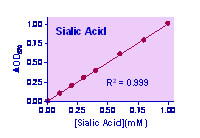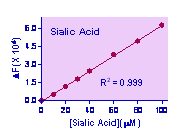
淀粉测试盒
产品名称: 淀粉测试盒
英文名称: EnzyChrom™ Sialic Acid Assay Kit
产品编号: ESLA-048, ESLA-100
产品价格: 0
产品产地: 美国
品牌商标: BioAssay Systems(美国博世)
更新时间: null
使用范围: null
- 联系人 :
- 地址 : 成都市新都区泰兴普河工业园105号
- 邮编 :
- 所在区域 : 四川
- 电话 : 点击查看
- 传真 : 点击查看
- 邮箱 : support@basbioinc.com
|
Description Sialic acid is a general name for nine carbon acidic sugars with N- or O-substituted derivatives. The most common member of these sugars is N-acetylneuraminic acid (NANA). Sialic acid is widely distributed throughout mammalian tissues and fluids including serum. Sialylated oligosaccharides have been shown to exhibit antiviral properties and are also known to influence blood coagulation and cholesterol levels. The Sialic acid level in body fluids is also an important marker for diagnosing cancer. Simple, direct and automation-ready procedures for measuring sialic acid concentrations find wide applications in research and drug discovery. BioAssay Systems sialic acid assay uses a single Working Reagent that combines NANA aldolase, pyruvate oxidase and hydrogen peroxide determination in one step. The color intensity of the reaction product at 570nm or fluorescence intensity at lem/ex = 585/530nm is directly proportional to sialic acid concentration in the sample.
Key features Sensitive and accurate. Use as little as 10 mL samples. Linear detection range in 96-well plate: 0.02 to 1 mM sialic acid for colorimetric assays and 2 to 100 mM for fluorimetric assays. Simple and convenient. Can detect free sialic acid by addition of a single working reagent and incubation for 60 min at room temperature or total sialic acid by pre-treating samples with a 60 min hydrolysis step.
Applications: Direct Assays: sialic acid in biological samples.
Kit Contents
Storage conditions. The kit is shipped on dry ice. Store all reagents at -20°C. Shelf life of three months after receipt.
Precautions: reagents are for research use only. Normal precautions for laboratory reagents should be exercised while using the reagents. Please refer to Material Safety Data Sheet for detailed information.
Bound Sialic Acid Hydrolysis Procedure Note: For measurement of free sialic acid, this procedure should be skipped. 1. Combine 20 mL of sample with 80 mL Hydrolysis Reagent in a microcentrifuge tube (screw cap tube is preferable) and incubate at 80°C for 60 min. 2. Allow sample to cool to room temperature and briefly centrifuge at 14000 rpm to spin down the hydrolysis mixture. 3. Add 20 mL Neutralization Reagent to each hydrolysis reaction, briefly vortex to mix and briefly centrifuge at 14000 rpm to spin down the reaction. The samples are now ready for the sialic acid assay. Coloriemtric Procedure Note: SH-group containing reagents (e.g. mercaptoethanol, DTT) may interfere with this assay and should be avoided in sample preparation. 1. Equilibrate all components to room temperature. Prepare a 1 mM Standard Premix by mixing 50 mL of the 10 mM Standard and 450 mL dH2O. Dilute Standard in distilled water as follows.
Transfer 10 mL standards and 10 mL samples into separate wells of a clear flat-bottom 96-well plate. 2. For each reaction well, mix 93 mL Assay Buffer, 1 mL Dye Reagent and 1 mL Enzyme in a clean tube. Transfer 90 mL Working Reagent |
|
into each assay well. Tap plate to mix. Freeze unused reagents for future use. 3. Incubate 60 min at room temperature. Read optical density at 570nm (550-585nm). Note: if the Sample OD is higher than the Standard OD at 1 mM, dilute sample in water and repeat the assay. Multiply result by the dilution factor.
CALCULATION Subtract blank OD (water, #4) from the standard OD values and plot the OD against standard concentrations. Determine the slope using linear regression fitting. The sialic acid concentration of a Sample is calculated as
where ODSAMPLE and ODH2O are the optical density values of the sample and water, Slope is the slope of the standard curve in mM-1 and n is the dilution factor of the sample (n = 6 for hydrolyzed samples and n = 1 for free Sialic Acid samples). Conversions: 1 mM NANA equals 30.9 mg/dL or 309 ppm. Fluorimetric Procedure 1. For fluorimetric assays, the linear detection range is 2 to 100 mM sialic acid. Dilute the Standards prepared in Colorimetric Procedure 1:10 in H2O. Transfer 10 mL standards and 10 mL samples into separate wells of a black 96-well plate. 2. Add 90 mL Working Reagent (see Colorimetric Procedure). Tap plate to mix. 3. Incubate 60 min at room temperature and read fluorescence at lex = 530nm and lem = 585nm. If assays in 384-well plate are desired, use 5mL Standards and 45 mL Working Reagent. The sialic acid concentration of a Sample is calculated as
where FSAMPLE and FH2O are the fluorescence values of the sample and water, Slope is the slope of the standard curve in mM-1 and n is the dilution factor of the sample (n = 6 for hydrolyzed samples and n = 1 for free Sialic Acid samples). Materials Required, but not provided Pipeting devices, centrifuge tubes, Clear flat-bottom 96-well plates, black 96-well or 384-well plates (e.g. Corning Costar) and plate reader.
Literature 1. Sugahara, K. et al. (1980). Enzymatic Assay of Serum Sialic Acid. Clinica Chimica Acta 108:493-8. TUNEology 波长可调检测卡盒-->
|


